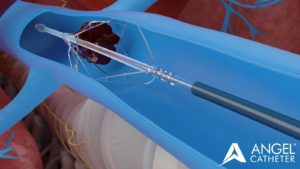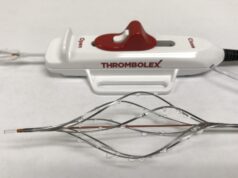
Bio2 Medical has announced that the Angel catheter, a new device for the prevention of pulmonary embolism, was placed in two patients at St Mary’s Medical Center in West Palm Beach, USA, by Lawrence Lottenberg and Robert Borrego on 29 September. This is the first commercial usage of the device.
The Angel catheter received 510(k) clearance from the US FDA as the first ever, prophylactic indication for a medical device to protect critically ill patients at high-risk for pulmonary embolism and contraindicated for anticoagulation.
The first patient was at high risk for pulmonary embolism due to traumatic brain injury post craniotomy. The second patient had prolonged immobilisation due to a cervical spinal cord injury and quadriplegia. Both patients were contraindicated to prophylactic anticoagulation for 7–10 days. The Angel catheter was placed at the bedside in the trauma intensive care unit, without the need for fluoroscopic guidance, allowing Lottenberg and Borrego to provide their patients with immediate pulmonary embolism prophylaxis.
Lottenberg stated: “The Angel catheter provides an unmet need for a prophylactic indication for the prevention of pulmonary emboli. Unlike traditional filters, the Angel catheter cannot migrate from its deployment position, and it is easily inserted and easily removable for patients who cannot be prophylactically anticoagulated during the immediate and early phases of injury. There are none of the complications seen in the many currently available inferior vena cava filters. This makes the device unique and one of a kind. The recognition of the value of this technology to patient safety and patient care by the Tenet Healthcare System and St Mary’s Hospital in bringing this technology to our level one trauma cannot be overstated.”
Borrego provided the following statement: “The placement of the Angel catheter at the bedside is a safe and efficient way to protect patients at high risk for pulmonary embolism, who cannot be anticoagulated for seven to ten days therefore protecting them from additional morbidity/mortality due to pulmonary embolism in high risk patients.”
Intended use of the Angel catheter
•The Angel catheter is intended to provide the combined functions of an inferior vena cava filter and a multilumen central venous catheter.
•The Angel catheter is intended for short-term use for the prevention of clinically significant pulmonary embolism in critically ill patients at high risk for pulmonary embolism or recurrent pulmonary embolism, and recognised contraindications to standard pharmacological thromboprophylaxis therapy.
•The Angel catheter is also intended to provide access to the central venous system.










